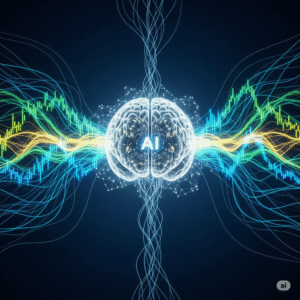Revolutionize Your Workflow with AI-Powered Efficiency
In today’s fast-paced professional landscape, time is a precious commodity. Every minute saved on mundane, repetitive tasks can be reinvested into strategic thinking, innovation, and client relationships. This is where Artificial Intelligence (AI) steps in, not as a replacement for human ingenuity, but as a powerful co-pilot, enhancing capabilities and supercharging efficiency. From streamlining communications to automating data analysis and even generating high-quality content, AI tools for productivity are no longer a luxury but a necessity for anyone looking to gain a competitive edge.
This article will delve into seven transformative AI tools for productivity that are revolutionizing how professionals work. We’ll explore their detailed use cases, provide real-world examples, and offer beginner-friendly workflows to help you integrate them seamlessly into your daily routine. Get ready to experience a new level of professional productivity AI has to offer.
Image Generation Prompt for Blog Header:
“A vibrant, dynamic image showcasing a diverse group of professionals working efficiently with glowing digital interfaces, stylized to represent AI assistance. Include subtle visual cues of data flowing, tasks being completed swiftly, and people smiling confidently. The background should be a modern, minimalist office setting with a futuristic, clean aesthetic. Use a color palette of blues, greens, and purples. Emphasize concepts of speed, intelligence, and seamless integration. Ideal for Midjourney, DALL·E, or Grok Vision.”
The AI Revolution in Professional Life: Saving Time, Boosting Impact
The promise of AI in the workplace isn’t just about doing more; it’s about doing better. By offloading time-consuming activities, professionals can focus on higher-value tasks that require uniquely human skills like critical thinking, creativity, and emotional intelligence.
Think about the sheer volume of emails, reports, data analysis, and content creation that fills an average workday. Each of these areas is ripe for AI optimization. Consider a marketing professional: instead of spending hours researching keywords and drafting social media copy, ai content writing tools can generate initial drafts, analyze sentiment, and even suggest optimal posting times. This shift frees up the marketer to refine brand messaging, engage with their audience, and develop impactful campaigns.
7 AI Tools That Will Transform Productivity
Let’s dive into the core of how AI can become your ultimate productivity partner. Here are seven categories of AI tools that are making a significant difference:
1. AI-Powered Writing Assistants & Content Generation
One of the most immediate impacts of AI on productivity is in the realm of writing. Whether it’s crafting emails, generating marketing copy, or drafting extensive reports, ai content writing tools are game-changers.
Tools to Explore:
- ChatGPT/Bard (or other LLMs): These large language models are incredibly versatile. You can use them to brainstorm ideas, draft outlines, summarize long documents, write emails, generate social media posts, and even help with coding snippets.
- Grammarly (Premium): Beyond basic grammar and spell-checking, Grammarly’s AI offers tone detection, conciseness suggestions, and plagiarism checks, ensuring your writing is clear, impactful, and original.
- Jasper/Copy.ai: Specifically designed for marketing and creative professionals, these tools excel at generating various forms of content, from blog posts and ad copy to product descriptions, often with different tones and styles.
Use Cases & Examples:
- Marketing & Sales: A small e-commerce business owner, Sarah, used to spend half a day writing product descriptions and social media posts. Now, with Jasper, she feeds in a few keywords and product features, and the AI generates compelling copy in minutes, saving her hours each week.
- Academics & Researchers: A university professor, Dr. Anya Sharma, leverages ChatGPT to summarize complex research papers, helping her quickly grasp key findings and identify relevant sources, drastically reducing her literature review time.
- Customer Service: Many companies use ai content writing tools to power chatbots that provide instant, accurate responses to common customer queries, freeing up human agents for more complex issues. (AI tools for Productivity)
Beginner-Friendly Workflow: Start by using ChatGPT to draft an email you usually spend a lot of time on. Provide clear prompts: “Write a professional email to a client requesting updated project requirements. Be polite but firm about the deadline.” Then, paste the draft into Grammarly for refinement.
2. Meeting Transcription & Summarization Tools
Meetings are essential, but the time spent taking notes and trying to recall key discussion points can be a drain. AI-powered transcription and summarization tools ensure no detail is missed and provide concise recaps.
Tools to Explore:
- Otter.ai: This tool records and transcribes meetings in real-time, identifying speakers and even generating summaries and action items.
- Fireflies.ai: Similar to Otter.ai, Fireflies.ai integrates with popular meeting platforms and offers AI-powered summaries, searchable transcripts, and key insights.
- Zoom AI Companion: Zoom’s native AI assistant can summarize meetings, generate action items, and answer questions about meeting content, directly within the platform.
Use Cases & Examples:
- Project Management: David, a project manager, uses Otter.ai for all his team meetings. Instead of assigning a note-taker, the AI transcribes everything, and he can quickly review the summary and action items, ensuring everyone is on the same page.
- Consulting: A consulting firm uses Fireflies.ai to record client calls. This allows consultants to fully engage in the conversation without worrying about detailed note-taking, and afterward, they can easily access key discussion points and client requests.
Practical Tip: Integrate these tools directly with your calendar and video conferencing software for automatic recording and transcription.
3. Smart Scheduling & Calendar Management
The back-and-forth of scheduling can be incredibly time-consuming. AI takes the hassle out of finding mutually agreeable times.
Tools to Explore:(AI tools for Productivity)
- Calendly: While not purely AI, Calendly uses intelligent algorithms to find optimal meeting slots based on your availability and preferences.
- Motion: This AI-powered calendar and task manager intelligently schedules your day, blocking out time for tasks and meetings based on your priorities and deadlines.
- Outlook/Google Calendar’s AI Features: Both platforms are integrating more AI to suggest meeting times, find available rooms, and even predict travel times.
Use Cases & Examples:
- Freelancers: A freelance graphic designer, Maria, used to spend an hour a week coordinating client calls. With Calendly, she simply sends a link, and clients book slots that work for both, saving her valuable design time.
- Sales Professionals: A sales team uses Motion to automatically schedule follow-up calls and prioritize outreach based on lead engagement, ensuring no hot lead falls through the cracks.
4. Data Analysis & Insights Platforms
AI can sift through vast datasets far more quickly and accurately than humans, identifying patterns, trends, and actionable insights that would otherwise be missed.
Tools to Explore:
- Tableau (with AI integrations): Tableau’s augmented analytics features use AI and machine learning to help users discover insights, explain data, and automate data preparation.
- Microsoft Power BI (with AI capabilities): Similar to Tableau, Power BI leverages AI to enhance data visualization and analysis, offering features like “Smart Narratives” that automatically generate text summaries of your data.
- ChatGPT/Bard for data querying: While not a dedicated data analysis tool, these LLMs can help you formulate complex data queries, interpret results, and even suggest ways to visualize data if you provide them with enough context.
Use Cases & Examples:
- Business Operations: A retail chain, “TrendStyle,” leveraged AI in their sales data. By analyzing historical sales patterns, weather data, and social media trends, their AI-powered platform predicted seasonal demand with 95% accuracy, reducing overstocking by 20% and increasing popular item availability. This was a monumental shift from manual forecasting, which often led to stockouts or excess inventory.
- Financial Analysis: A financial analyst, Rajesh, used to spend days building complex Excel models. Now, with AI-powered analytics tools, he can feed in raw financial data and quickly generate reports with predictive insights on market trends and investment opportunities.
Case Study: “Innovate Solutions” – Revolutionizing Client Reporting
“Innovate Solutions,” a mid-sized marketing agency, struggled with the sheer volume of client reports. Each month, their analytics team spent hundreds of hours manually compiling data from various platforms (Google Analytics, social media insights, ad platforms) into digestible reports. The process was not only time-consuming but also prone to human error.
They implemented an AI-powered data visualization and reporting tool that integrated with their existing marketing platforms. Now, the AI automatically pulls data, identifies key performance indicators (KPIs), generates charts and graphs, and even writes narrative summaries explaining the results.
Result: The time spent on reporting was reduced by 70%, freeing up their analytics team to focus on strategic client recommendations and proactive campaign optimization. Client satisfaction also increased due to the speed and depth of insights provided.
5. AI for Project Management & Task Automation
AI can streamline project workflows, automate repetitive tasks, and even help prioritize your to-do list, ensuring you stay on track and meet deadlines.
Tools to Explore:
- Notion AI: Integrates directly into your Notion workspaces to help you brainstorm, summarize, translate, and even automate content creation for your notes, tasks, and documents.
- Asana/Trello (with Butler automation): While not inherently AI, these platforms allow for extensive automation through rules and integrations, which can mimic AI-like behavior for task assignment, status updates, and notifications.
- Zapier (with AI integrations): Zapier, a powerful automation tool, now integrates with numerous AI applications. You can build “Zaps” (automated workflows) that incorporate AI steps, such as using AI to summarize emails before adding them to a project management tool or classifying incoming support tickets. (See Zapier’s guide on AI automation: https://zapier.com/blog/zapier-ai-guide/)
Use Cases & Examples:
- Small Business Owner: Emily, who runs a small online boutique, uses Zapier to automate her order fulfillment. When a new order comes in, Zapier uses an AI tool to generate a personalized thank-you email to the customer, updates her inventory in her e-commerce platform, and notifies her shipping provider, all without manual intervention.
- Software Development: A software team uses Notion AI to quickly generate project outlines and meeting notes. The AI helps them structure their sprints and summarize daily stand-ups, keeping everyone informed and aligned.
Beginner-Friendly Workflow: Start by automating a simple, repetitive task. For instance, use Zapier to automatically add new email attachments to a specific folder in your cloud storage and then use an AI tool (like ChatGPT via Zapier) to summarize the content of the attachment.
6. AI-Powered Design Tools
Even creative tasks benefit from AI, accelerating the design process and making professional-looking visuals accessible to everyone.
Tools to Explore:
- Canva (with Magic Studio): Canva’s Magic Studio offers AI-powered features for generating images, transforming text into images, creating presentations, and even designing entire websites from prompts.
- Adobe Express: Similar to Canva, Adobe Express integrates AI tools for quick design tasks, background removal, and content generation.
- Midjourney/DALL-E/Grok Vision: These advanced AI image generators allow you to create unique, high-quality visuals from text prompts, perfect for blog headers, social media graphics, and presentations.
Use Cases & Examples:
- Content Creators: A blogger, Liam, uses Midjourney to create unique, eye-catching header images for his articles, saving him time and money on stock photos or hiring a designer.
- Small Businesses: A local cafe owner, Priya, uses Canva’s AI features to quickly design promotional flyers and social media posts for her daily specials, creating professional marketing materials in minutes.
7. Personalized Learning & Skill Development with AI
AI isn’t just about direct task completion; it can also accelerate your professional growth by personalizing learning experiences and providing targeted insights.
Tools to Explore:
- Perplexity AI: Acts as a powerful research assistant, providing direct, cited answers to your questions by Browse the web in real-time. This is invaluable for quickly understanding new concepts or industry trends.
- Personalized Course Platforms (e.g., Coursera, Udemy with AI tutors): Many online learning platforms are integrating AI tutors and personalized learning paths, adapting content to your progress and weaknesses.
- Language Learning Apps (e.g., Duolingo with AI tutors): AI-powered language apps offer personalized feedback and practice, accelerating language acquisition for global business professionals.
Use Cases & Examples:
- Career Advancement: Sarah, an aspiring data scientist, uses Perplexity AI to quickly understand complex algorithms and programming concepts, accelerating her learning journey by providing concise, accurate explanations with sources.
- Global Business: Mark, a sales executive expanding into new markets, uses an AI-powered language app to improve his Spanish, allowing him to build stronger relationships with his Latin American clients.
Case Study: “GrowthHack Marketing” – Scaling Content Creation
“GrowthHack Marketing,” a burgeoning digital marketing agency, faced a common challenge: scaling their content output to meet client demands while maintaining quality. Their small team of content writers was constantly overwhelmed with research, drafting, and optimization. They wanted to integrate ai content writing tools but feared a loss of their unique brand voice.
Also, They adopted a hybrid workflow. They invested in a premium ai content writing tool (like Jasper) and trained their writers to use it as a powerful first-draft generator. The AI would handle initial research and outline creation, and then generate various versions of articles, blog posts, and social media copy. Their human writers then focused on refining these drafts, injecting the agency’s and clients’ specific brand voices, adding nuanced insights, and optimizing for SEO.
Result: Content production increased by 40% within three months without hiring additional writers. The quality remained high, and the writers, freed from repetitive initial drafting, could focus on strategic content planning and creative storytelling. This allowed “GrowthHack Marketing” to take on more clients and expand its service offerings.
Embracing the AI Future for Ultimate Productivity
The integration of AI tools for productivity into our daily professional lives is not a question of if, but when and how. By understanding their capabilities and implementing them strategically, you can unlock unprecedented levels of efficiency and effectiveness. From powerful ai content writing tools to intelligent scheduling and advanced data analysis, AI is here to augment your abilities and empower you to achieve more.
Remember, the key is to start small, experiment with different tools, and identify what works best for your specific needs and industry. The future of professional productivity AI is collaborative, allowing humans to focus on what they do best – innovate, strategize, and connect – while AI handles the heavy lifting. (AI tools for Productivity)
How to Write Blog Posts with AI (Step-by-Step)



